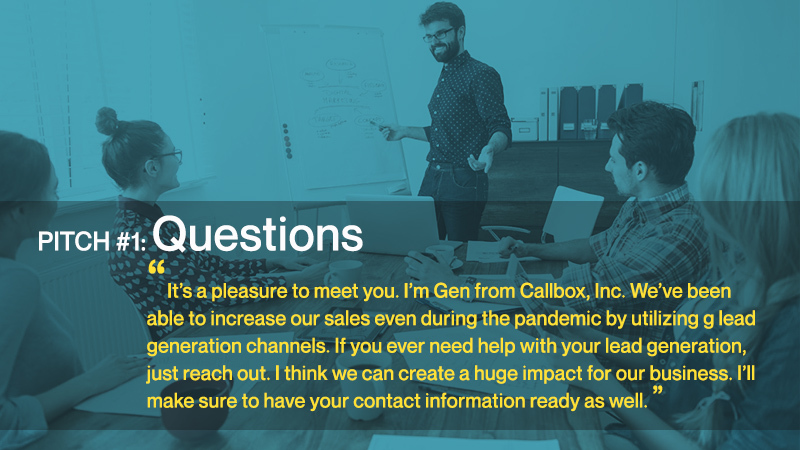One of the factors that can make or break your product or service offering. It sets the precedent for the other person whether to engage in a conversation with you or not. So how do you present yourself during a meeting to make people want more from you?
In this article, we will be presenting 7 elevator pitch examples that will catch your listener hook, line, and sinker. It doesn’t matter whether you are a professional or a first-timer, the examples we will give will cover you no matter what situation you’re in.
But before that…
What is an Elevator Pitch?
In a nutshell, an elevator pitch is a brief introduction about yourself, what you do, and what you are offering. It’s an icebreaker, a prelude to making a meaningful connection. And through that, you could stir curiosity and leave your listeners wanting for more.
You might not be aware of it, but you might have given a number of elevator pitches in your life — from interviews and proposals to investor meetings and business opportunities.
An elevator pitch may vary in length, but the most ideal is around 30 seconds. That’s because our attention span only lasts around eight seconds. However, this guideline is not set in stone. You can make it longer, depending on the industry you’re in and what you are pitching. The most important thing is it should contain the most important points you want to say.
Another factor that contributes to a successful elevator speech is the person you’re delivering it to. As a rule of thumb, you should go for the best point of contact. Those who are interested in or related to what you are offering. By doing so, you’ll have a better chance of winning them over to your side.
Anatomy of an Elevator Pitch
When writing your elevator pitch, don’t give a history lesson on your business. Include only the most relevant and recent details. You will be able to do that if you have carefully researched who you’re going to talk to. You also need to understand the basic components of an effective elevator speech.
Introduction
You have the freedom of how you want to introduce yourself. You can start by stating your name and your company. Or you can start with a good joke to break the ice. But no matter how you do it, make it sound natural and relevant — something your audience is familiar with.
Make the introduction short and direct to the point. And don’t forget your body language and eye contact.
Problem
After the introduction, talk about their pain points. It will set the stage for the solution you have. For example, discerning high-quality leads from the bad ones.
Use real-world examples so your audience can relate. It’s much better if you’re going to use their experiences. Making them the star of your story will grab their attention. Moreover, this exercise might help them become aware of the problem they have overlooked.
Solution
The solution you bring makes them realize why they need your skills and expertise. For example, Callbox helps you get high-quality leads for your business, qualify and nurture them, and convert them into buying customers.
Presenting your solution is crucial to the success of your elevator pitch; so take time crafting it to perfection. Fine-tune it so it fits your audience. Share the uniqueness of your solution and why it would greatly benefit them.
Value Proposition
The solution is the icing while your value proposition is the cake. It’s the element that will seal the deal because it will show your prospect why your solution is better than the competition. For example, Callbox is the only lead generation agency that connects prospects through six different channels.
Engagement
After you present everything, your job does not stop here. You need to keep your prospect engaged even when you’re saying goodbye. They have to keep wanting more. After that, don’t forget to swap information.
7 Most Effective Elevator Pitches to Attract Tech Buyers
Now that we have covered the basics, it’s time to look at some of the most effective elevator pitches we have compiled.
Pitch #1: Questions

Tech buyers love problem-solving. After all, that’s how innovation starts — with a question. So it makes sense when you present your pitch in a question form like this one:
Have you ever felt frustrated about getting quality leads that convert? You have so many leads but they stop after the trial period. But you know what? After utilizing all 6 lead generation channels with various tools and strategies, we tripled our sales. Have you ever tried something similar to this?
Pitch #2: Statistics

Presenting tech buyers with stats is another exciting topic in the industry. Data and figures have a premium in this group because that’s what they use to solve a problem. Here’s an example of a stat-driven elevator pitch:
Did you know that only 56% of B2B companies, including the tech industry, check valid leads? No wonder a lot of companies are still struggling in boosting their sales. By contacting leads faster, you have a bigger and better chance of converting them.
Pitch #3: Story
This type of elevator pitch uses your own experience or customer testimonials to create a compelling story for the audience. It’s a good strategy if you only have 30 seconds to introduce yourself.
We have a client that has difficulty getting customers because of the pandemic. With our help, they were able to generate leads by 73%, enabling them to retain all their employees.
Pitch #4: One-liners
We are not talking about cliche one-liners but facts or statistics that are relevant to their business. Here’s an example:
63% of buyers requesting information on your company now will not purchase for at least 3 months. What tools and strategies do you have in place to seamlessly guide them to a buying decision?
Pitch #5: Talking to a business owner or entrepreneur

Business owners are warier than C-Suites when it comes to new investments. If you want to win them, use examples pertaining to their business as you present the problem and solution.
I love your products at XY Enterprises. I admire your vision, but I realized that a lot of people have missed the opportunity of working with your company. Have you ever used various channels to generate more leads? I think it could greatly impact your business growth in the long term.
Pitch #6: Sales Pitch

Salespeople often use incomprehensible sales jargon that drives prospects away. The key to success is establishing a real connection sprinkled lightly with selling your product. Start with a personal story instead of the usual sales presentation.
We have experienced great setbacks caused by the lockdowns during the pandemic. We were on the verge of laying out some of our employees. Thankfully, we found a solution to our dilemma. Exploring new and novel channels for generating leads enabled us to find new clients. Each business has a different strategy for getting new leads but I can confidently say our tools and strategy were exceptional at getting high-quality leads that we didn’t let go of anyone in our team.
Pitch #7: Virtual event
A virtual networking event is common these days. It is also challenging in making meaningful conversations. But no matter how difficult it is, be ready to deliver a compelling elevator pitch. You’ll never know who you’ll be talking to no matter where you are.
It’s a pleasure to meet you. I’m Gen from Callbox, Inc. We’ve been able to increase our sales even during the pandemic by utilizing g lead generation channels. If you ever need help with your lead generation, just reach out. I think we can create a huge impact on our business. I’ll make sure to have your contact information ready as well.
Fine-Tuning Your Elevator Pitch
Aside from creating an awesome elevator pitch, you need to fine-tune your delivery. Don’t punish your listeners with a boring speech. We are not just talking about the content but also the tone you use and your posture when delivering it.
Here are four tips to keep in mind:
- Stick to your script – it will help you stay on topic. You might not say it word for word, but memorizing most of it will make you more confident. It will also prevent you from forgetting the most important points.
- Speak clearly – even if you feel nervous, do not show it. Relax and speak slowly so your listeners can understand you. However, be aware that it is not too slow or you will bore them.
- Record your speech – recording your speech before you deliver allows you to see areas that need improvement. Practice and record your speech a number of times until you can confidently say that it is enough.
- Practice – it might sound cliche but practice makes perfect.
An elevator pitch is an opportunity to present a prospectus of your strengths and solutions. It might be scary but try using the suggestions we gave you and develop your own strategy.
While the elevator speech is important to attract more people to your business, there are many more ways to boost your sales and revenue. And one of those methods is by generating high-quality leads that have a 99 percent chance of becoming a customer.
The article is originally published on Callbox - The Savvy Marketer



